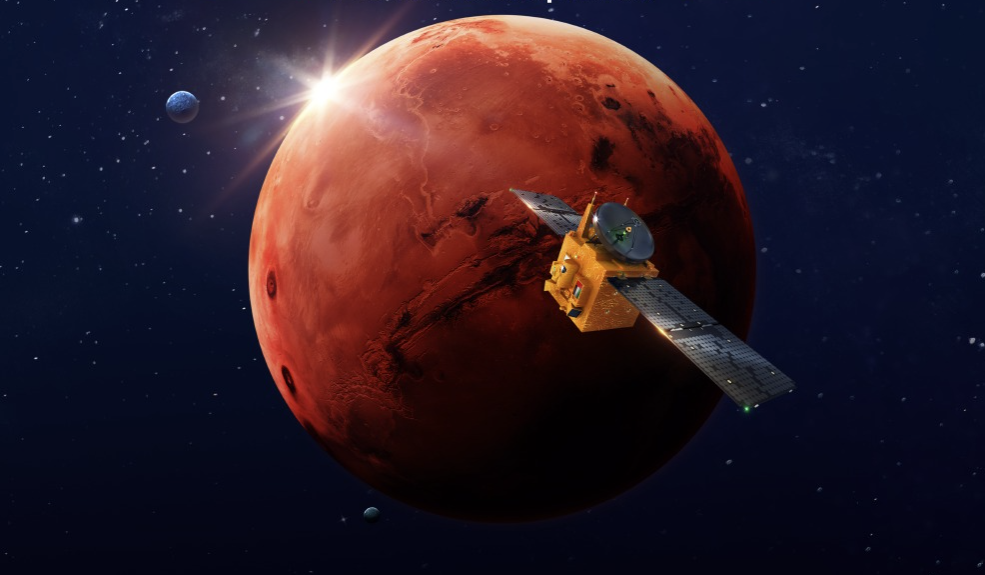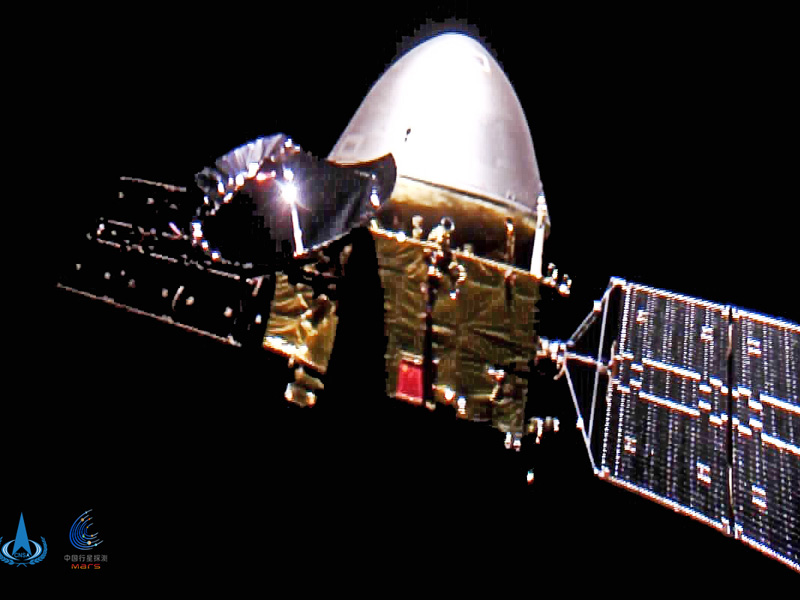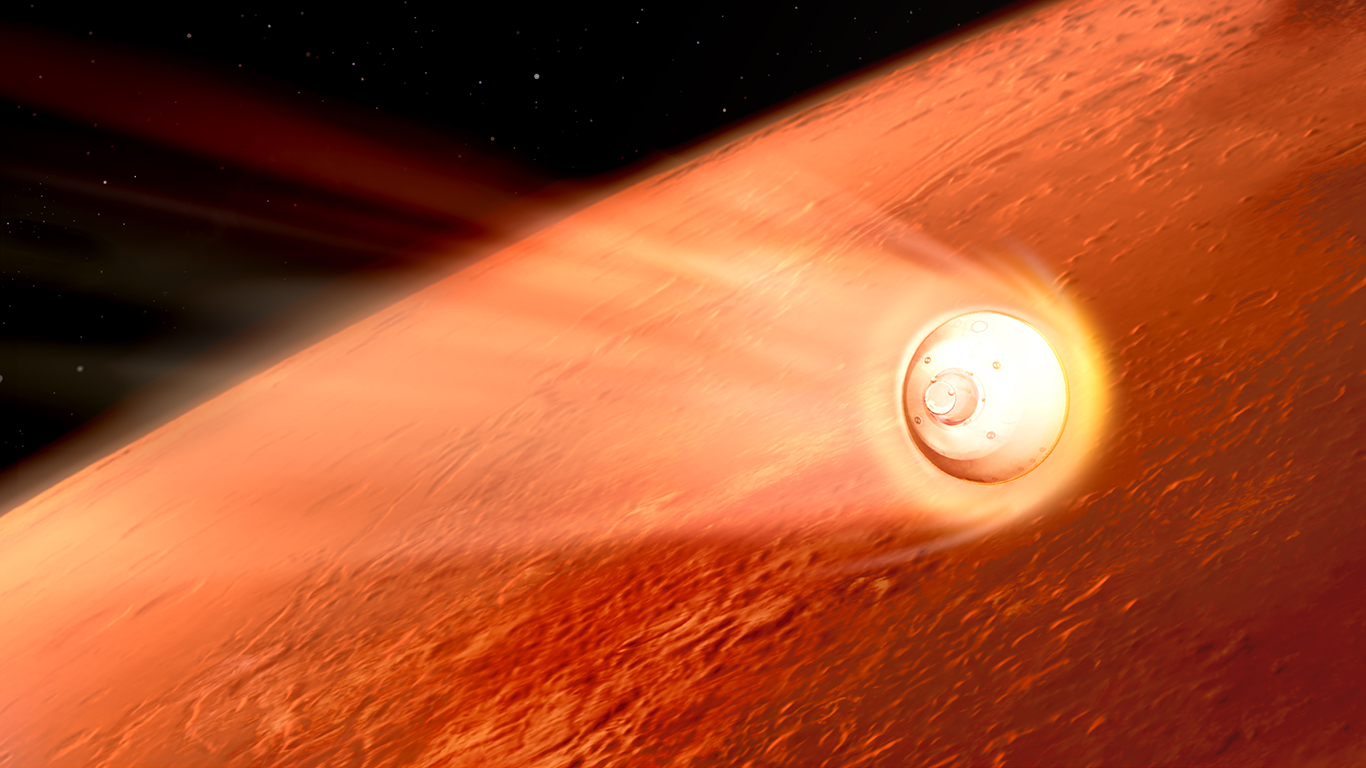

News
NASA Mars rover promises blazing entrance after China, UAE make it to Mars orbit
The month of the robotic invasion of Mars is upon us. Seven months ago, the United States, China, and the United Arab Emirates launched missions on a 300 million mile (480 million kilometer) journey to Mars.
Last week, two of the three missions quietly arrived and inserted themselves into Mars orbit. The final spacecraft to arrive, NASA’s Mars 2020 Perseverance mission, however, will not go gently into the Martian atmosphere. On Thursday, February 18, NASA’s latest Mars mission destined to uncover evidence of ancient microbial life on the distant planet is set to touchdown following a spectacular display of extremely complex engineering.
Getting to Mars
Launching to the Red Planet is a strategic maneuver that can only be completed once every two years. This is due to the varying speeds and the elliptical shape of the planets’ orbits around the sun. The point at which Earth and Mars are aligned close enough to minimize travel time, called an opposition, occurs only once every two years.
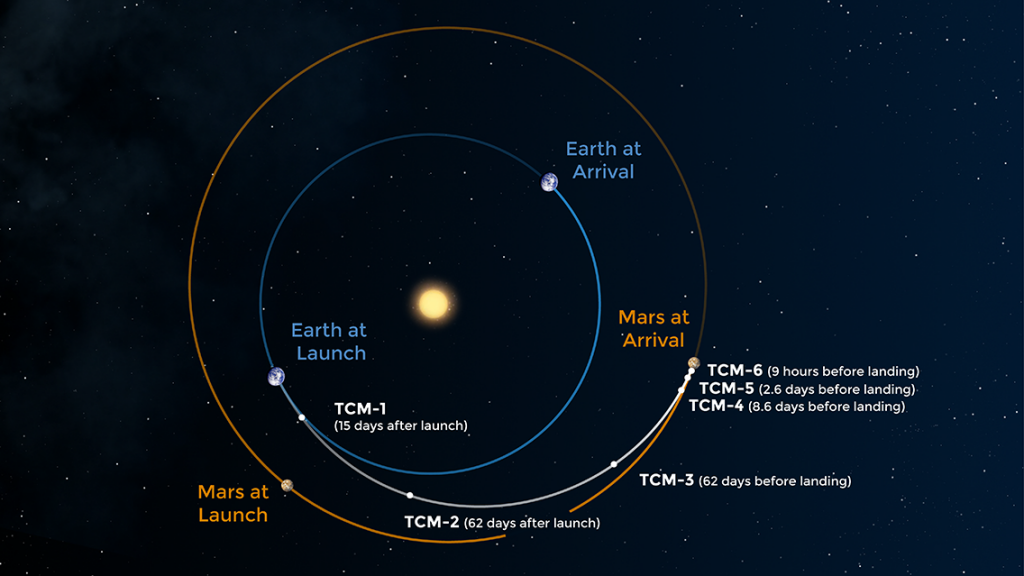
The update that's rolling out to the fleet makes full use of the front and rear steering travel to minimize turning circle. In this case a reduction of 1.6 feet just over the air— Wes (@wmorrill3) April 16, 2024
The most recent opposition occurred in July 2020. Four international Mars missions were intended to leave Earth that summer, however, due to required further certification of parachutes the European Space Agency’s ExoMars Rosalind Franklin rover would have to wait for its launch opportunity during the next planetary opposition to occur in 2022. That left three robotic invaders from the United States, the United Arab Emirates, and China to escape Earth’s orbit and become interplanetary superstars.
Hope arrives to Mars
The United Arab Emirates Space Agency’s first-ever interplanetary mission, a spacecraft named Al-Amal, or the Hope Probe, was developed in collaboration between the Mohammed bin Rashid Space Center, Laboratory for Atmospheric and Space Physics at the University of Colorado Boulder, Arizona State University, and the Space Sciences Lab at the University of California, Berkeley. It was launched on July 19, 2020, from Tanegashima Space Centre in Japan aboard an H2A202 rocket. On Tuesday, February 9, the Hope Probe was the first of the three missions to complete the journey to Mars and successfully insert itself into orbit.
The Hope Probe arrived to near-Mars orbit traveling approximately 75,000 mph (121,000 kph), far too fast to successfully achieve a safe Martian orbital insertion maneuver. In order to slow down to the approximate 11,000mph (18,000 kph) needed to be captured by Mars orbit, the spacecraft had to autonomously fire its main thrusters and perform a Mars Orbit Insertion burn lasting an agonizing 27 minutes. To compensate in the instance of a thruster failure, there was a backup safety protocol that would’ve doubled the length of the burn. After 27 grueling minutes, the Mohammad Bin Rashid Space Center located in Dubai reported that the maneuver was completed successfully and the Hope Probe had arrived at its final destination.
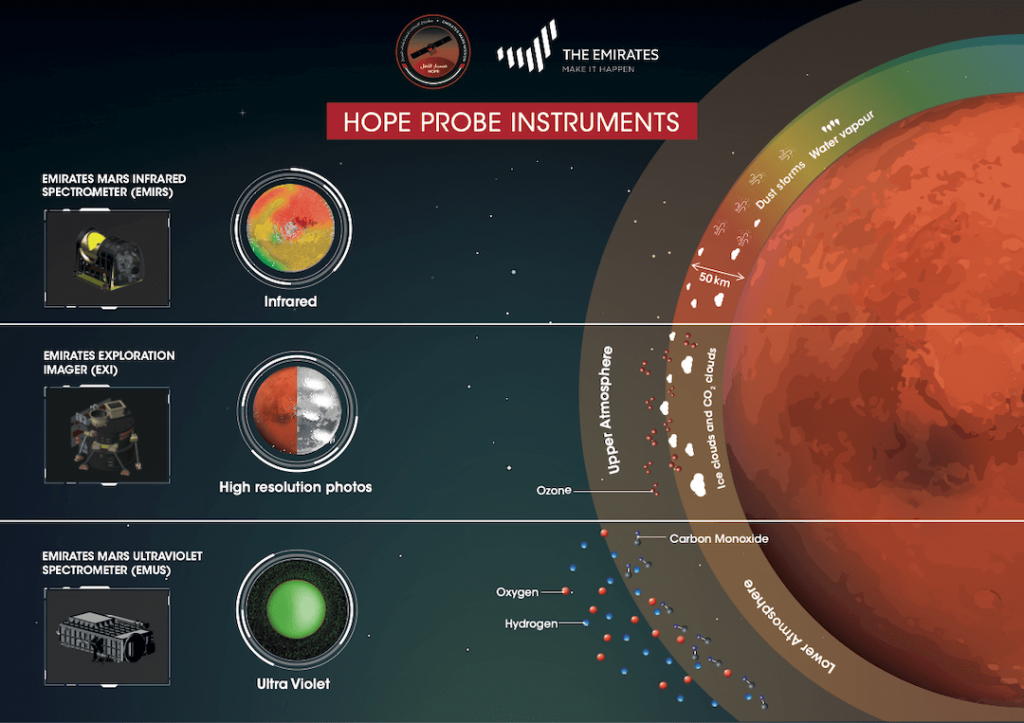
Unlike the American and Chinese missions to Mars which will land rovers on the surface, the United Arab Emirates’ Hope Probe will remain in Mars orbit for the duration of its mission – approximately two Martian years. The spacecraft is equipped with a suite of three instruments, two spectrometers – one infrared and one ultraviolet – to study the Martian atmosphere, and one imager to capture high-resolution images to study the surface from afar.
China’s Tianwen-1 Rover will hang out in orbit before landing in May
The same type of Mars Orbit Insertion maneuver was completed by China’s first interplanetary mission, the Tianwen-1 spacecraft. Launched from China on July 23, 2020, Tianwen-1 arrived at Mars orbit just one day after the Hope Probe on Wednesday, February 10.
The Tianwen-1 spacecraft had to autonomously complete an excruciating 11-minute “braking” burn to slow down which took it behind the planet as it was captured by Mars gravity and entered into orbit.
Like NASA’s Perseverance, the Tianwen-1 mission features a rover that will eventually land on the surface of Mars. The process to get the rover to the surface, however, varies from that of NASA’s Mars 2020 Perseverance mission.
The Tianwen-1 spacecraft is made of two components, an orbiter and a rover. Currently, it is planned that the orbiter will spend some time in Mars orbit for a period of comprehensive observation before attempting a landing of the rover in May. Ideally, the spacecraft will then touch down in a region known as Utopia Planitia.
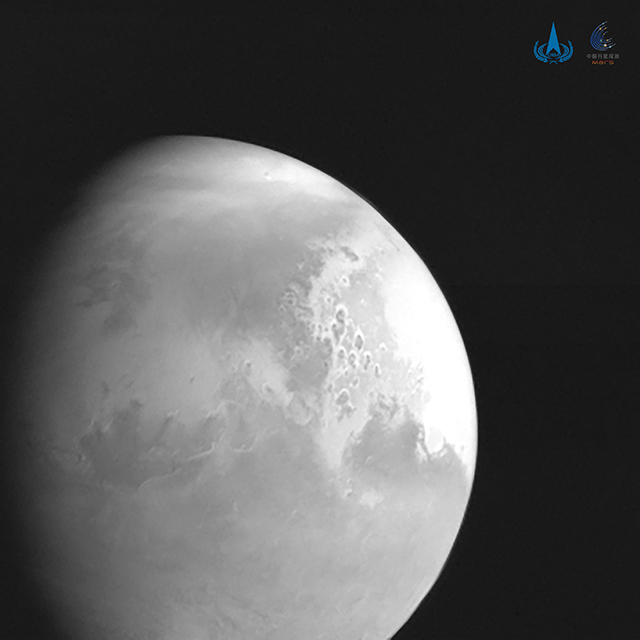
The update that's rolling out to the fleet makes full use of the front and rear steering travel to minimize turning circle. In this case a reduction of 1.6 feet just over the air— Wes (@wmorrill3) April 16, 2024
Once the rover safely makes it to the surface it will initiate the investigation period of the mission. The rover carries a suite of scientific instruments that will be used to investigate the composition of the Martian surface searching for the potential distribution of water and ice. Similar to China’s Yutu 2 rover which is exploring the Moon, the Tianwen-1 rover also carries a panoramic camera to image the planet.
Perseverance and Ingenuity like no other
The last of the three Mars missions – NASA’s Mars 2020 Perseverance mission launched on July 30, 2020, from Cape Canaveral Space Force Station aboard a United Launch Alliance Atlas 5 rocket. As far as Mars arrivals go, the best has certainly been saved for last. Following the success of the other two missions from China and the United Arab Emirates, the stage is set for Perseverance to make its dramatic entrance.
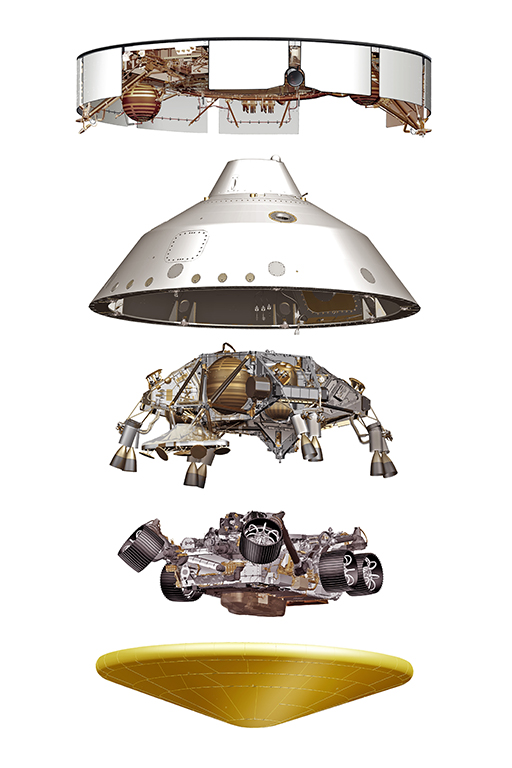
NASA’s Mars 2020 Perseverance mission is by far the most ambitious mission to launch to Mars during the 2020 planetary transfer window. NASA is not attempting to land one, but two spacecraft on the surface of Mars. The $2.4 billion Mars 2020 mission is comprised of the Perseverance rover – powered by the heat produced by radioactive decay of Plutonium – and a first of its kind rotary helicopter called Ingenuity. It is scheduled to arrive in dramatic fashion on Thursday, February 18.
Rather than conducting a braking maneuver to slow down and enter Mars orbit, the Perseverance spacecraft will autonomously conduct the entry, descent, and landing (EDL) procedure – essentially going from traveling several thousand miles an hour to descending slowly under a parachute canopy to softly land in mere minutes.
The spacecraft – housed in a protective aeroshell with its robust heat shield facing the planet’s surface – will burst into Mars’ atmosphere traveling nearly 12,500 mph (20,000 kph). Once through, Pesevereance will ditch its heat shield and autonomously begin scanning the Martain terrain to determine its relative location and make adjustments to find an optimal landing spot. Then, a powered descent module will deploy transporting the rover the rest of the way down slowing to less than 2mph (3kph). Finally, the descent module will hover and deploy a complex harness system lowering Perseverance – and its stowaway, the Ingenuity helicopter – to the Martian surface for touchdown.

After seven months of interplanetary travel, it all comes down to the final seven minutes – the length of time the EDL process is expected to take. All spacecraft controllers back on Earth can do is watch and wait for that final telemetry reading indicating that Perseverance has successfully touched down. That is why this process has earned the nickname “seven minutes of terror.”
Beginning around 11:15 am PST (19:15 UTC) on Thursday, February 18th, NASA will provide live coverage of Perseverance’s landing attempt. The agency will carry the coverage on NASA TV and its website, as well as a number of other platforms including YouTube, Twitter, Facebook, LinkedIn, Twitch, Daily Motion, Theta.TV, and NASA App.

Elon Musk
Starlink passes 9 million active customers just weeks after hitting 8 million
The milestone highlights the accelerating growth of Starlink, which has now been adding over 20,000 new users per day.

SpaceX’s Starlink satellite internet service has continued its rapid global expansion, surpassing 9 million active customers just weeks after crossing the 8 million mark.
The milestone highlights the accelerating growth of Starlink, which has now been adding over 20,000 new users per day.
9 million customers
In a post on X, SpaceX stated that Starlink now serves over 9 million active users across 155 countries, territories, and markets. The company reached 8 million customers in early November, meaning it added roughly 1 million subscribers in under seven weeks, or about 21,275 new users on average per day.
“Starlink is connecting more than 9M active customers with high-speed internet across 155 countries, territories, and many other markets,” Starlink wrote in a post on its official X account. SpaceX President Gwynne Shotwell also celebrated the milestone on X. “A huge thank you to all of our customers and congrats to the Starlink team for such an incredible product,” she wrote.
That growth rate reflects both rising demand for broadband in underserved regions and Starlink’s expanding satellite constellation, which now includes more than 9,000 low-Earth-orbit satellites designed to deliver high-speed, low-latency internet worldwide.
Starlink’s momentum
Starlink’s momentum has been building up. SpaceX reported 4.6 million Starlink customers in December 2024, followed by 7 million by August 2025, and 8 million customers in November. Independent data also suggests Starlink usage is rising sharply, with Cloudflare reporting that global web traffic from Starlink users more than doubled in 2025, as noted in an Insider report.
Starlink’s momentum is increasingly tied to SpaceX’s broader financial outlook. Elon Musk has said the satellite network is “by far” the company’s largest revenue driver, and reports suggest SpaceX may be positioning itself for an initial public offering as soon as next year, with valuations estimated as high as $1.5 trillion. Musk has also suggested in the past that Starlink could have its own IPO in the future.
News
NVIDIA Director of Robotics: Tesla FSD v14 is the first AI to pass the “Physical Turing Test”
After testing FSD v14, Fan stated that his experience with FSD felt magical at first, but it soon started to feel like a routine.

NVIDIA Director of Robotics Jim Fan has praised Tesla’s Full Self-Driving (Supervised) v14 as the first AI to pass what he described as a “Physical Turing Test.”
After testing FSD v14, Fan stated that his experience with FSD felt magical at first, but it soon started to feel like a routine. And just like smartphones today, removing it now would “actively hurt.”
Jim Fan’s hands-on FSD v14 impressions
Fan, a leading researcher in embodied AI who is currently solving Physical AI at NVIDIA and spearheading the company’s Project GR00T initiative, noted that he actually was late to the Tesla game. He was, however, one of the first to try out FSD v14.
“I was very late to own a Tesla but among the earliest to try out FSD v14. It’s perhaps the first time I experience an AI that passes the Physical Turing Test: after a long day at work, you press a button, lay back, and couldn’t tell if a neural net or a human drove you home,” Fan wrote in a post on X.
Fan added: “Despite knowing exactly how robot learning works, I still find it magical watching the steering wheel turn by itself. First it feels surreal, next it becomes routine. Then, like the smartphone, taking it away actively hurts. This is how humanity gets rewired and glued to god-like technologies.”
The Physical Turing Test
The original Turing Test was conceived by Alan Turing in 1950, and it was aimed at determining if a machine could exhibit behavior that is equivalent to or indistinguishable from a human. By focusing on text-based conversations, the original Turing Test set a high bar for natural language processing and machine learning.
This test has been passed by today’s large language models. However, the capability to converse in a humanlike manner is a completely different challenge from performing real-world problem-solving or physical interactions. Thus, Fan introduced the Physical Turing Test, which challenges AI systems to demonstrate intelligence through physical actions.
Based on Fan’s comments, Tesla has demonstrated these intelligent physical actions with FSD v14. Elon Musk agreed with the NVIDIA executive, stating in a post on X that with FSD v14, “you can sense the sentience maturing.” Musk also praised Tesla AI, calling it the best “real-world AI” today.
News
Tesla AI team burns the Christmas midnight oil by releasing FSD v14.2.2.1
The update was released just a day after FSD v14.2.2 started rolling out to customers.

Tesla is burning the midnight oil this Christmas, with the Tesla AI team quietly rolling out Full Self-Driving (Supervised) v14.2.2.1 just a day after FSD v14.2.2 started rolling out to customers.
Tesla owner shares insights on FSD v14.2.2.1
Longtime Tesla owner and FSD tester @BLKMDL3 shared some insights following several drives with FSD v14.2.2.1 in rainy Los Angeles conditions with standing water and faded lane lines. He reported zero steering hesitation or stutter, confident lane changes, and maneuvers executed with precision that evoked the performance of Tesla’s driverless Robotaxis in Austin.
Parking performance impressed, with most spots nailed perfectly, including tight, sharp turns, in single attempts without shaky steering. One minor offset happened only due to another vehicle that was parked over the line, which FSD accommodated by a few extra inches. In rain that typically erases road markings, FSD visualized lanes and turn lines better than humans, positioning itself flawlessly when entering new streets as well.
“Took it up a dark, wet, and twisty canyon road up and down the hill tonight and it went very well as to be expected. Stayed centered in the lane, kept speed well and gives a confidence inspiring steering feel where it handles these curvy roads better than the majority of human drivers,” the Tesla owner wrote in a post on X.
Tesla’s FSD v14.2.2 update
Just a day before FSD v14.2.2.1’s release, Tesla rolled out FSD v14.2.2, which was focused on smoother real-world performance, better obstacle awareness, and precise end-of-trip routing. According to the update’s release notes, FSD v14.2.2 upgrades the vision encoder neural network with higher resolution features, enhancing detection of emergency vehicles, road obstacles, and human gestures.
New Arrival Options also allowed users to select preferred drop-off styles, such as Parking Lot, Street, Driveway, Parking Garage, or Curbside, with the navigation pin automatically adjusting to the ideal spot. Other refinements include pulling over for emergency vehicles, real-time vision-based detours for blocked roads, improved gate and debris handling, and Speed Profiles for customized driving styles.
